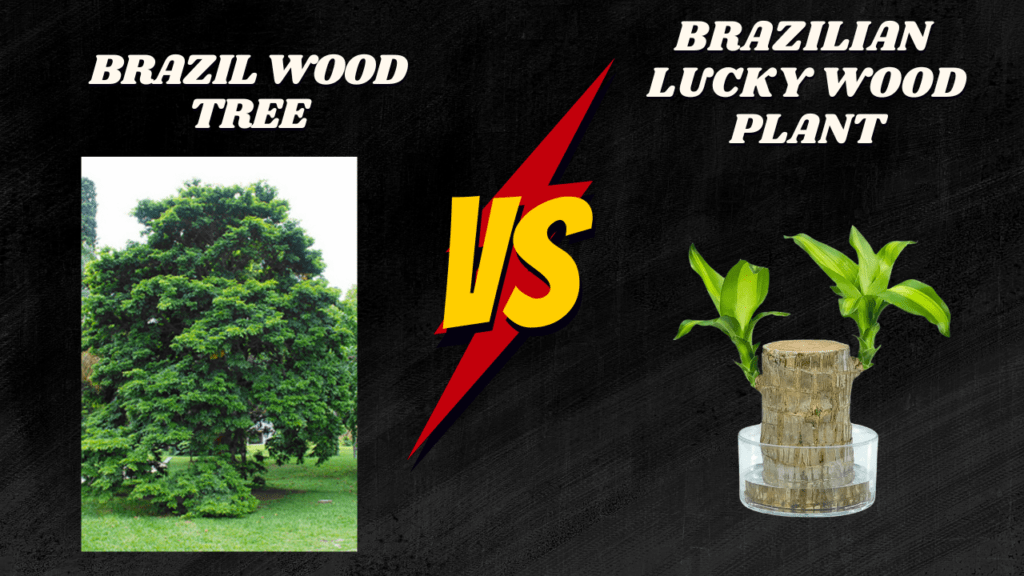
Brazilwood Tree and Brazilian Lucky Wood Plant – Two interesting botanical gems from Brazil and both with a blend of cultural, ecological and ornamental importance. Aside from a relation to Brazil and their name, these species are completely different plants with their own features, reports on how to grow them and symbolism.
In this informative blog post, we shall discuss the differences between the Brazilwood Tree or Pau-brasilia echinata and its rival the Brazilian Lucky Wood Plant or Pachira aquatica. We will also give you tips on how to care for each one, the best uses for the two natural plants, and answer some of the most common questions that people have about them.
The Brazilwood Tree: Nature’s National Treasure
Botanical Profile and Importance
The Brazilian Wood Tree (Paubrasilia echinata), commonly called Pau-Brasil, is a moderate-sized tree in the Fabaceae family, and is found in the Atlantic Forest of Brazil. It is known for its deep reddish heartwood, used to make a highly valued red dye called brazilin, and it is a good wood for making violin bows and other fine woodwork.
It is noteworthy as a culturally and historically significant species, and for the first few centuries after discovery of this new world it was the only source of a red coloring for textiles. Its importance was such that, for most of that time, the name of the country as it is known today was given to it; it also lent its name (whereby it is also known locally) to the valuable commodity known as Brazilwood itself.
Now that Brazilwood is endangered and threatened by over-logging and habitat destruction the need to protect this iconic tree has become desperate.
How to Care for the Brazilwood Tree
Brazilwood is largely a tropical tree which does best under certain conditions. It is typically cultivated outside, however with the proper care it can be cultivated as a decorative indoor plant.
Light: Prefers bright, indirect sunlight. Leaves can be scorched by direct sun.
Water: Keep soil evenly moist, but not waterlogged, which can cause root rot. Water approximately once a week, when the topsoil feels dry.
Temperature – It likes to be in warm temperatures of 65°F to 85°F (18°C to 29°C).
Humidity: Prefers moderate to high humidity; some misting or use of a humidity tray indoors can have a positive effect.
SoilWell-draining, slightly acidic to neutral soil (pH 6.0–7.0) is optimal.
Pruning Remove the old leaves as they turn yellow and cut off any damaged leaves with scissors to keep your plant looking its best.
Fertilizer: Apply a balanced, water-soluble fertilizer once a month in spring and summer.
Benefits and Symbolism
More than meets the eye, the Brazilwood Tree also represents strength and tradition. It’s a symbol of strength and life and is a valuable target species within conservation biology. Its name comes from it being a popular source of firewood, being a hard and durable wood and reddish in colour. Ecologically, the maintenance of Brazilwood trees in the wild helps protect biodiversity in the Atlantic Forest biome.
The Brazilian Lucky Wood Plant: The Charm of Indoor Gardening
What is the Brazilian Lucky Wood Plant?
The Brazilian Lucky Wood Plant is the Pachira aquatica, with it’s unique braided trunks and emerald green foliage. This tropical indoor plant has become a fan favorite as it’s known in the practice of Feng Shui to bring good luck, good fortune and positive vibes. The feature of the product, unique plants are hydroponically grown (without soil) to grow in water in the plant-up to difficult in the indoor environment.
How to Take Care of the Brazilian Lucky Wood Plant
This plant is easy to care for, so it’s ideal for newbie plant parents or for those enthusiasts with a busy schedule.
Light: Performs best in bright, indirect light, but will also survive in low light; keep out of direct sunlight.
Water: If you are growing your air plants in water, change the water 1-2 weeks to avoid stagnating and root rot. If potted in soil, water deeply, but allow the topsoil to dry out a bit between waterings.
Heat: Likes its tropical home so keep it warm (65°F to 85°F).
Humidity: Tolerant but prefers moderate humidity.
Soil: If planting in the ground, use well-draining soil.
Trim: Remove dying or yellowing leaves for better growth.
Growth: Grows up to 1-5 feet tall indoors and grow very fast if taken care good.
Benefits and Significance
The Brazilian Lucky Wood Plant is more than just decoration — it’s a symbol of resiliency and luck. Its connectedness with Feng Shui brings some to hold onto it in consideration of good fortune, positive mood, and abundance in their home or workplace. It can even purify the air, trapping indoor pollutants and making your air cleaner.
Key Differences Between Brazilwood Tree and Brazilian Lucky Wood
| Feature | Brazilwood Tree (Paubrasilia echinata) | Brazilian Lucky Wood Plant (Pachira aquatica) |
| Plant Type | Hardwood tropical tree | Tropical indoor ornamental plant |
| Size | Up to 15 meters | Usually 1-5 feet indoors |
| Wood/Foliage | Dense red heartwood; pinnate leaves | Green glossy leaves; braided woody trunks |
| Growth Environment | Native to Atlantic Forest; outdoor growth | Indoor or outdoor; grows in soil or water |
| Cultivation Difficulty | Requires controlled tropical environment | Low maintenance, easy indoor care |
| Symbolism | Cultural heritage, resilience, ecological importance | Prosperity, good luck, Feng Shui symbol |
| Watering Needs | Moderate; keep soil moist but not waterlogged | Change water weekly if in hydroponics; soil should dry between waterings |
| Light Requirements | Bright indirect light | Bright indirect light or low light tolerance |
Frequently Asked Questions (FAQs)
Q1: Can a Brazil Wood tree be grown indoors?
Pretty Yes it can be grown indoors if given enough light (Bright Indirect), humidity and don’t over watering any more then house plants.
Q2: There is a brazil for lucky wood plant, how frequently to change the water?
If you’re growing in water there is risk of root rot and bacteria build up if it’s not changed every 1-2 weeks.
Q3: Why soil is necessary for the Brazilian Lucky wood?
No, it doesn’t need soil, and can even grow in water, but it will also prosper in well-draining potting mix.
Q4: Is the Brazilwood tree an endangered plant?
Yes, it’s endangered so much so that it’s one of the critically endangered due to habitat and overfishing. It is important to save it, as it plays a role in the ecological equilibrium.
A5: What are the advantages of having these plants inside the home?
Brazilian Lucky Wood cleans the air and it attracts positive energy.»Brazilwood is a gorgeous wood with a beautiful appearance, its meaning is similar to a Brazilian palisander wood: strength and protection.
Conclusion
While the two plants, Brazilwood Tree and Brazilian Lucky Wood Plant, are both native to Brazil and have symbolic representations, they play a very different role. The Brazilwood Tree is a majestic hardwood that has significant cultural and conservation value, while the Brazilian Lucky Wood Plant is an attractive, low maintenance houseplant that is believed to bring luck and fortune.
Each adds value to its setting—one as an environmental and historical heirloom and the other with its beauty, significance and ease of cultivation.
Knowing the differences and their care needs allow these botanical wonders to remain robust and continue to inspire admiration for Brazilian flora.

